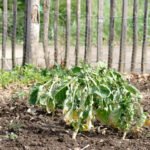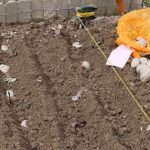Gardening with landscape fabrics can dramatically transform your vegetable garden and yield impressive results. These innovative materials not only provide an aesthetic appeal but also offer numerous benefits for the overall health and productivity of your plants. By using landscape fabrics, you can create a more controlled environment that promotes optimal growth, spacing, and protection against weeds.
Landscape fabrics are specially designed textiles that are used to cover the soil in gardening and landscaping projects. They work by creating a barrier that prevents weed seeds from germinating and penetrating the surface, greatly reducing the need for manual weeding. Additionally, these fabrics allow water, air, and nutrients to pass through while providing sun protection, moisture retention, and temperature regulation for the roots.
One of the primary advantages of using landscape fabrics in vegetable gardening is their ability to conserve moisture in the soil. The fabric acts as a shield against evaporation, keeping the root zone consistently moist. This is particularly beneficial during dry spells or in regions with limited access to water resources. Furthermore, by reducing weed competition and moisture loss, landscape fabrics contribute to higher water efficiency within your garden.
The improved spacing achieved through the use of landscape fabrics is also vital for healthy vegetable growth. Proper spacing ensures adequate access to sunlight and airflow around each plant, preventing excessive shade or overcrowding that can lead to disease susceptibility. Moreover, optimized spacing allows for efficient use of nutrients in the soil by minimizing competition among neighboring plants.
What are landscape fabrics and how do they work in a garden setting?
Landscape fabrics are an essential tool for vegetable gardeners looking to improve their gardening experience and increase the health and productivity of their plants. These fabrics are made from durable, permeable materials such as woven polypropylene or polyester. They are designed to suppress weed growth, conserve moisture, regulate soil temperature, and prevent soil erosion.
In a garden setting, landscape fabrics work by creating a barrier between the soil and the environment. The fabric is usually laid down on top of prepared soil before planting vegetables. It allows water, air, and nutrients to pass through to the roots of the plants while blocking sunlight and inhibiting weed growth. By preventing weeds from competing with vegetables for resources, landscape fabrics help promote healthier vegetable growth and higher yields.
One of the main advantages of using landscape fabrics in a vegetable garden is weed control. Weeds can quickly spread throughout a garden bed and compete with vegetables for essential resources such as nutrients, water, and sunlight. Landscape fabrics act as a physical barrier that prevents weeds from growing by blocking out light and inhibiting their germination. This reduces the need for manual weeding and makes it easier to maintain a clean and tidy garden space.
Another advantage of using landscape fabrics is moisture conservation. The fabric helps to retain moisture in the soil by reducing evaporation rates. This is particularly beneficial during hot summer months when water availability may be limited or during drought conditions. By conserving moisture in the root zone, landscape fabrics ensure that plants have access to adequate hydration which is crucial for healthy growth.
Overall, landscape fabrics are an effective tool for managing weeds and conserving moisture in vegetable gardens. They create an ideal growing environment for vegetables by regulating soil temperature, preventing erosion, improving nutrient uptake efficiency, reducing weed competition, and conserving soil moisture levels. Gardeners who use these fabrics often find that they spend less time on maintenance tasks such as weeding or watering while enjoying improved crop health and increased yields.
| Advantages of Landscape Fabrics in Vegetable Gardening |
|---|
| Weed control |
| Moisture conservation |
| Regulation of soil temperature |
| Prevention of soil erosion |
| Improved nutrient uptake efficiency |
| Increased crop health and yields |
The advantages of using landscape fabrics in vegetable gardening
Landscape fabrics offer several advantages when used in vegetable gardening.
Firstly, landscape fabrics act as a barrier, preventing weeds from growing and competing with vegetables for resources such as nutrients and sunlight. Weeds can be a major nuisance in vegetable gardens, not only stealing resources but also providing a habitat for pests and diseases. By using landscape fabrics, gardeners can minimize the need for manual weeding and save time and effort in maintaining their vegetable garden.
Secondly, landscape fabrics help conserve moisture in the soil. They reduce evaporation by acting as a shield and blocking the direct contact between the soil surface and the sun’s rays. This can be especially beneficial in hot climates or during dry spells when water conservation is crucial. By reducing water loss through evaporation, gardeners can ensure that their vegetables receive an adequate water supply, promoting healthy growth and development.
Additionally, landscape fabrics create a microclimate around vegetable plants. The fabric acts as an insulator by trapping heat during cooler periods of the day and releasing it into the surrounding environment during colder periods. This can help extend the growing season for certain vegetables or protect them from frost damage in early spring or late fall. By using landscape fabrics, gardeners can take advantage of these microclimatic benefits to optimize their vegetable production.
Overall, using landscape fabrics in vegetable gardening offers numerous advantages such as weed control, moisture conservation, and creating favorable microclimates. Gardeners who incorporate these fabrics into their gardening practices will likely experience healthier plants with increased yields. With proper installation and maintenance techniques, landscape fabrics can be a valuable tool for any vegetable gardener seeking to maximize productivity while minimizing maintenance efforts.
| Advantages | Explanation |
|---|---|
| Weed Control | Landscape fabrics act as a barrier that prevents weeds from growing and competing with vegetables for resources. |
| Moisture Conservation | Landscape fabrics reduce evaporation, helping to conserve moisture in the soil which is crucial during hot climates or dry spells. |
| Microclimate Creation | Landscape fabrics create a microclimate around vegetable plants by trapping heat and protecting them from frost damage, thereby extending the growing season. |
Choosing the right landscape fabric for your vegetable garden
Firstly, you need to choose a landscape fabric made from a material that is both durable and breathable. The fabric should be able to withstand the elements and resist tearing or degrading over time. It is also important for the fabric to allow air and water to pass through easily so that the roots of your vegetables can access oxygen and moisture.
Next, consider the thickness of the landscape fabric. A thicker fabric will offer more protection against weeds by blocking sunlight more effectively. However, if you choose a fabric that is too thick, it may impede water penetration and hinder root development.
Permeability is another important factor to consider. The landscape fabric should have adequate drainage properties to prevent waterlogging in the soil. This is especially important for vegetable gardens as excess moisture can lead to root rot and other diseases.
Additionally, it is essential to select a landscape fabric that is UV-resistant. The intense sunlight can quickly deteriorate fabrics that are not designed for outdoor use. Look for fabrics with UV inhibitors or coatings that provide protection against harmful UV rays.
Finally, consider the size of the roll when choosing a landscape fabric for your vegetable garden. Measure your gardening area beforehand so that you purchase enough material to fully cover your desired space. It may be beneficial to buy in bulk if you have a large garden or plan on expanding in the future.
By carefully selecting the right landscape fabric for your vegetable garden, you can create an environment that promotes healthy plant growth while minimizing weed competition and soil erosion. Take into account these factors when making your choice, and enjoy all the advantages that come with gardening using landscape fabrics in your vegetable garden.
Preparing the soil and installing landscape fabrics for optimal spacing
Preparing the soil is an essential step in creating a successful vegetable garden with landscape fabrics. It is important to ensure that the soil is well-draining and free of weeds before installing the fabric. Here are some steps to follow for preparing the soil:
Clearing the area
Start by clearing the area where you plan to install the landscape fabrics. Remove any existing plants, debris, and weeds from the site. This will prevent any unwanted growth under the fabric and ensure that your vegetables have ample space to grow.
Testing and amending the soil
Before planting your vegetables, it’s a good idea to test the soil for its pH level and nutrient content. You can do this by using a soil testing kit or sending a sample to a local agricultural extension office. Based on the results of the test, you can amend the soil accordingly. Adding organic matter such as compost or well-rotted manure can help improve soil fertility and structure.
Installing the landscape fabric
Once your soil is prepared, it’s time to install the landscape fabric for optimal spacing. Lay out the fabric over the cleared area, ensuring that it covers all areas where you want to plant your vegetables. Secure the fabric at its edges with garden staples or rocks to keep it in place.
While installing landscape fabrics, be mindful of proper spacing between plants. Proper spacing allows each plant enough room for air circulation and prevents competition for water and nutrients.
Cutting holes for planting
Using a utility knife or scissors, carefully cut holes in the landscape fabric where you intend to plant each vegetable. Make sure that these holes are slightly larger than their respective root balls or seedlings to allow for easy planting.
When cutting holes in the fabric, make sure they are evenly spaced according to recommended guidelines for each type of vegetable.
By properly preparing your soil and installing landscape fabrics for optimal spacing, you can create an ideal environment for your vegetables to thrive.
Proper spacing techniques for different types of vegetables when using landscape fabrics
Proper spacing is essential for healthy vegetable growth in any garden, and this holds true when using landscape fabrics as well. While landscape fabrics can provide numerous benefits to a vegetable garden, such as weed control and moisture retention, it is important to ensure that the plants have enough space to grow and thrive. In this section, we will explore some techniques for proper spacing of different types of vegetables when using landscape fabrics.
Spacing for leafy greens
Leafy greens such as lettuce, spinach, and kale require adequate spacing to allow air circulation and prevent diseases. When using landscape fabrics, consider leaving a gap between the plants so that each plant has enough room to spread its leaves. For example, lettuce plants should be spaced around 8-12 inches apart in rows separated by 12-18 inches.
Spacing for root vegetables
Root vegetables like carrots, radishes, and beets need sufficient space for their roots to develop properly. When planting these vegetables with landscape fabrics, make sure to leave enough space between each plant so that the roots have room to grow. Carrots typically require 2-4 inches between each plant in rows spaced around 12-18 inches apart.
Spacing for vining vegetables
Vining vegetables such as cucumbers, squash, and melons tend to spread out and take up more space compared to other vegetables. To accommodate their growth when using landscape fabrics, give these plants ample space between each other so they can sprawl without being cramped. Cucumbers usually need around 12-18 inches of spacing between plants in rows that are about 24-36 inches apart.
It is crucial to research the specific spacing requirements of different vegetable varieties you plan to grow in your garden while considering the use of landscape fabrics. By adhering to these guidelines for proper spacing, you can ensure that your plants have enough space to grow and thrive while still benefiting from the advantages of landscape fabrics.
In the next section, we will discuss how to maintain your vegetable garden with landscape fabrics in terms of watering, fertilizing, and weed control. Proper maintenance is key to achieving successful outcomes when gardening with landscape fabrics.
Maintaining the vegetable garden with landscape fabrics
Maintaining your vegetable garden with landscape fabrics is essential to ensure the healthy growth of your plants. Proper watering, fertilizing, and weed control are key aspects of garden maintenance that need to be considered when using landscape fabrics.
One of the advantages of using landscape fabrics in vegetable gardening is its ability to retain water. The fabric acts as a barrier, preventing evaporation and reducing water loss from the soil. However, it is important to regularly check the moisture level of the soil to ensure proper hydration for your plants.
You can use an irrigation system or water directly at the base of each plant, allowing the water to penetrate through the fabric and reach the roots. Providing adequate water will promote strong root development and overall plant health.
Fertilizing is another critical aspect of maintaining a vegetable garden with landscape fabrics. While the fabric helps prevent nutrient leaching, it is still necessary to provide your plants with essential nutrients for optimal growth. Before installing the fabric, incorporate organic matter such as compost or well-rotted manure into the soil to enrich its fertility. Additionally, you can apply slow-release organic fertilizer on top of the fabric or use liquid fertilizers that are specifically formulated for vegetables.
Weed control is greatly facilitated by landscape fabrics as they act as a physical barrier against weed growth. However, some weeds may still manage to sprout around your plants or through small gaps in the fabric. Regular inspection and hand weeding are necessary tasks to keep your vegetable garden weed-free. When hand weeding, take care not to disturb or damage the roots of your vegetables.
Potential challenges and solutions when gardening with landscape fabrics
Gardening with landscape fabrics can offer numerous benefits for vegetable gardens, such as preventing weed growth, conserving moisture, and protecting plants from temperature fluctuations. However, like any gardening method, there may be potential challenges that arise when using landscape fabrics. Here are some common challenges that gardeners may face and effective solutions to overcome them:
- Soil Drainage Issues: One challenge with using landscape fabrics is that they can impede proper drainage of water in the soil. This can lead to waterlogged roots and other problems for vegetable plants. To address this issue, ensure that the fabric you choose has adequate permeability to allow water to pass through. Additionally, it’s important to properly prepare the soil before installing the fabric by incorporating organic matter to improve drainage.
- Overheating of Roots: Landscape fabrics can absorb and retain heat from the sun, which may result in overheating of plant roots during hot summer months. To mitigate this challenge, consider selecting a fabric with reflective properties or use shade covers over the fabric during peak hours of sunlight. It is also essential to monitor moisture levels and provide sufficient irrigation to keep the roots cool.
- Pest Management: While landscape fabrics can help prevent weed growth, they may inadvertently create favorable conditions for pests such as slugs or snails. These pests can hide beneath the fabric or find refuge in any crevices created by the fabric installation process.
An effective solution is to regularly inspect and remove any pests found within or around the fabric areas. Additionally, implementing natural pest control measures like handpicking or using organic deterrents can help manage these pests effectively. - Fabric Degradation: Over time, landscape fabrics may degrade due to exposure to sunlight and weather conditions. As a result, their effectiveness in suppressing weed growth may diminish after several years of use. To address this challenge, it is recommended to monitor the condition of your landscape fabric annually and replace it as needed. Regular maintenance and occasional spot checks can help identify any areas of fabric that require repair or replacement.
By being aware of these potential challenges and utilizing the practical solutions provided, gardeners can successfully overcome them when gardening with landscape fabrics. With proper planning, installation, and maintenance, landscape fabrics can continue to provide a multitude of benefits for vegetable gardens while minimizing any possible drawbacks.
Success stories and testimonials from experienced vegetable gardeners using landscape fabrics
Many experienced vegetable gardeners have found great success in using landscape fabrics in their gardening practices. These gardeners have reported numerous benefits that have improved not only the health of their crops but also their overall gardening experience.
One success story comes from Sarah, who has been using landscape fabrics in her vegetable garden for several years now. She shares that the use of landscape fabrics has greatly reduced the amount of time and effort needed for weed control.
By blocking out sunlight, the fabric inhibits weed growth and reduces competition for nutrients, allowing Sarah’s vegetables to thrive better. She also mentions that because there are fewer weeds to compete with her plants, she has been able to achieve higher yields and healthier crops.
Another testimonial comes from Mark, who has a challenging gardening situation where his vegetable garden is prone to erosion due to heavy rainfall. Mark decided to try using landscape fabrics after researching methods to prevent erosion. He installed the fabric on sloping areas of his garden, securing it with stakes and gravel. This simple solution not only helped prevent erosion but also acted as a barrier against pests, such as slugs and snails, ensuring his vegetables remained pest-free.
These success stories highlight just a couple of ways in which experienced vegetable gardeners have benefited from using landscape fabrics. Each gardener may have different experiences depending on their specific needs and gardening conditions, but overall, many have found that these fabrics offer significant advantages in terms of weed control, moisture retention, insect prevention, and overall plant health.
By sharing these success stories and testimonials from experienced vegetable gardeners who have used landscape fabrics successfully in their own gardens, it becomes apparent just how effective this method can be at improving vegetable growth and overall gardening experience. It encourages other aspiring or novice gardeners to consider implementing landscape fabrics in their own gardens to enjoy these benefits firsthand.
Conclusion
In conclusion, gardening with landscape fabrics can provide numerous benefits for vegetable gardens. The use of landscape fabrics helps to control weeds, retain moisture in the soil, and regulate soil temperature, which ultimately leads to healthier vegetable growth. By choosing the right landscape fabric for your specific garden needs and properly preparing the soil, you can optimize spacing and create an ideal growing environment for your plants.
Proper spacing techniques are crucial when using landscape fabrics in vegetable gardening. Different types of vegetables have different spacing requirements, so it is important to research and understand the specific needs of each plant. By following recommended spacing guidelines, you can ensure that each plant has enough room to grow and thrive. This not only maximizes yield but also minimizes competition between plants for resources.
Maintaining your vegetable garden with landscape fabrics requires proper watering, fertilizing, and weed control. These fabrics help conserve moisture in the soil, but regular watering is still necessary to keep plants hydrated. Fertilizing should be done according to the specific needs of your vegetables, taking into consideration any nutrient deficiencies in your soil. Additionally, while landscape fabrics help control weed growth, it is important to regularly inspect and remove any weeds that may penetrate through the fabric.
Gardening with landscape fabrics does present its own set of challenges and potential issues such as adequate drainage or pests infestation; However, with proper planning and careful selection of suitable fabrics thicknesses, these challenges can be managed effectively.
Overall it is evident that gardening with landscape fabrics has a great potential for future growth. As more people become aware of their benefits and learn how to properly utilize them in their gardens, we can expect an increasing number of success stories from experienced vegetable gardeners. With careful attention paid to proper spacing techniques and maintenance practices, more fruitful harvests are within reach for all those who choose this method.
So why not give it a try? Enhance your gardening experience by incorporating landscape fabrics into your vegetable garden and enjoy the many benefits it brings in terms of healthier plants, higher yields, and easier maintenance.
Frequently Asked Questions
How do you plant vegetables with landscape fabric?
Planting vegetables with landscape fabric involves a few key steps. First, prepare the soil by removing any weeds or debris. Next, lay the landscape fabric over the prepared soil, making sure it covers the entire planting area. Secure the fabric in place with stakes or pins to prevent it from shifting or being blown away.
Then, make small cuts or slits in the fabric where you want to plant your vegetables. These openings should be just big enough for the plants’ roots to pass through. Plant your vegetables directly into the soil beneath these cuts and ensure that they are well-watered after planting. The landscape fabric will help suppress weed growth, conserve moisture, and regulate soil temperatures for healthy vegetable growth.
How close can landscape fabric be to plants?
When using landscape fabric around plants, it is important to maintain an appropriate distance between the fabric and the plant itself. While landscape fabric can provide various benefits such as weed control and moisture conservation, it may hinder the growth of plants if placed too closely.
To ensure healthy plant development, leave some space between the landscape fabric and individual plants to allow room for their roots to expand and for water and nutrients to reach them efficiently. This spacing depends on the size of your plants – smaller plants may require less clearance than larger ones.
Can you put landscape fabric around tomato plants?
Yes, it is possible to use landscape fabric around tomato plants. In fact, using landscape fabric in tomato beds can offer several advantages for successful cultivation. Tomato plants benefit from landscape fabric’s ability to suppress weed growth and conserve moisture in the soil while allowing air circulation around their stems.
When using this material, follow the same general guidelines mentioned earlier: prepare the soil, anchor down the fabric securely, cut slits or holes in appropriate locations for planting tomato seedlings or transplants so that their roots can penetrate into the ground beneath. Overall, incorporating landscape fabric around tomato plants can help promote healthy growth while minimizing competition from unwanted weeds.

If you’re looking to get into vegetable gardening, or are just looking for some tips on how to make your current garden better, then you’ve come to the right place! My name is Ethel and I have been gardening for years. In this blog, I’m going to share with you some of my best tips on how to create a successful vegetable garden.





